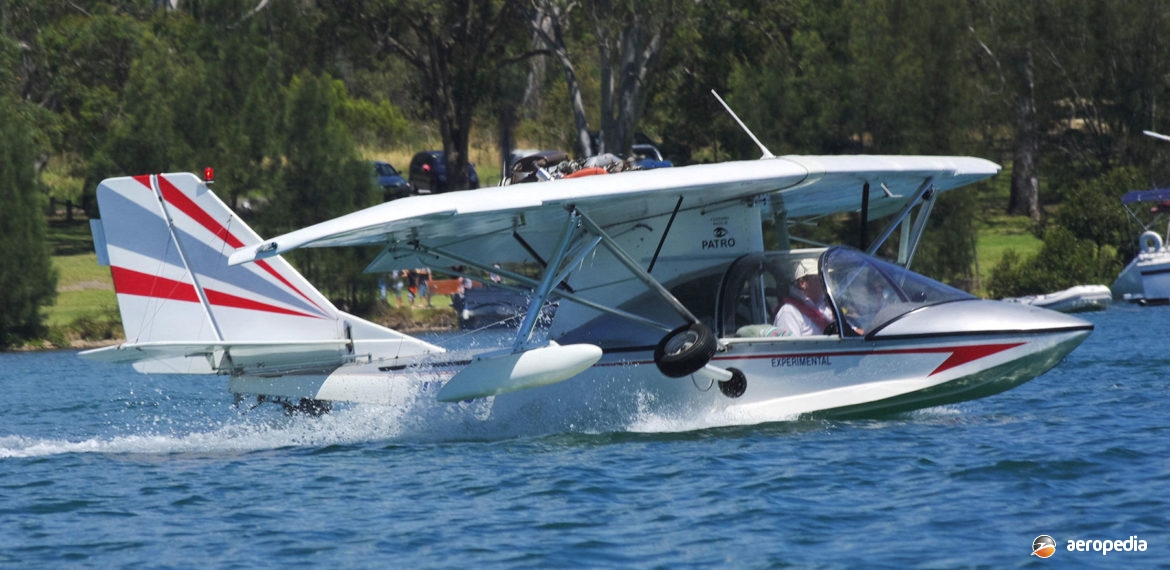Photograph:
Progressive Aerodyne SeaRey VH-DUX (c/n IDK146/Q240) at Rathmines, NSW on Lake Macquarie, NSW in October 2010 (David C Eyre)
Country of origin:
United States of America
Description:
Two-seat light sport amphibian
Power Plant:
One 80 kw (100 hp) Rotax 912 four-cylinder four-stroke liquid-and-air-cooled engine
Specifications:
- Wingspan: 9.40 m (30 ft 8 in)
- Length: 6.83 m (22 ft 4 in)
- Height: 1.95 m (6 ft 4 in)
- Wing area: 14.58 m² (158 sq ft)
- Max speed: 177 km/h (110 mph)
- Max cruising speed: 153 km/h (95 mph)
- Cruising speed at 75% power: 145 mph (90 mph)
- Stalling speed flaps down: 61 km/h (38 mph)
- Stalling speed flaps up: 76 km/h (47 mph)
- Take-off ground roll: 107 m (350 ft)
- Take-off on water: 144 m (472 ft)
- Take-off over 15 m (50 ft) on land: 427 m (1,400 ft)
- Take-off over 15 m (50 ft) on water: 465 m (1,525 ft)
- Rate of climb: 198 m/min (650 ft/min)
- Service ceiling: 3,962 m (13,000 ft)
- Fuel capacity: 87 litres (19 Imp gals)
- Range with 30 mins reserve at 75% power: 584 km (363 miles)
- Empty weight: 340 kg (750 lb)
- Payload: 222 kg (490 lb)
- Loaded weight: 649 kg (1,430 lb)
History:
The SeaRey is produced in kit form by Progressive Aerodyne Inc of Orlando, Florida. An amphibian, it was introduced to the market in 1992 and could be fitted with a variety of engines in the 48 kw (65 hp) to 75 kw (100 hp) range, but is usually fitted with the Rotax 912 engine in the pusher configuration. Construction is of metal tube with fabric covering and some composite material is used in the fuselage. The type has a tailwheel type undercarriage retracted by a single lever with overcentre locks. The series is available in two model. The StingRay, which is slightly smaller, is fitted with engines in the 30 kw (40 hp) to 48 kw (65 hp) range, usually the Rotax 447 or 582 engines. It is usually registered in the ultralight category and has a gross weight of 363 kg (800 lb). The SeaRey has a larger cabin and seats two side-by-side, the hull being built of light-weight reinforced fibreglass.
The first of the type seen in this region was shown partially completed at an aviation event at Mangalore, VIC at Easter 1996, becoming VH-REY (c/n IDK106/0196/001). However, during testing in July 1996 it was damaged at Chipping Norton, NSW on the Georges River, and was dismantled for a rebuild. Since then a number of others have been completed and registered, including VH-MWD (c/n N430) which later became VH-ZUP, VH-WIW (c/n V342), VH-DRU (c/n N450), VH-YEM (c/n Q230), VH-IIL (c/n N479), VH-DUX (c/n IDK146), VH-AJB (c/n N471), VH-CRA (c/n N521), VH-BCU (c/n N426), VH-JLJ (c/n IDK238), VH-JTL (c/n IDK402C) and VH-EGM (c/n IDK231). Some 30 odd examples have been constructed and built in Australasia. Others have been registered under Recreation Aviation Australia regulations.
Examples completed in New Zealand include ZK-REY (c/n IMK177), ZK-SRY (c/n IMK230), ZK-WET (c/n IDK451C), ZK-YAY (c/n IDK365C) and ZK-ZET (c/n N471).
Michael Smith, a member of the Australian Seaplane Pilots Association, completed a circumnavigation of the world in his SeaRey in 2015, arriving at Longreach, QLD on 12 November 2015. His aircraft (registered N473XP) named Southern Sun left Melbourne, VIC in April 2015 to loosely follow the Qantas Empire flying boat route from Sydney to London which was operated in the 1930s with Short Empire flying boats. The trip was then extended to cross North America before flying across the Pacific Ocean to Asia and Australia. In the seven months of the trip covering 210 days he visited 25 countries, made 80 stops, completed 83 flights, and recorded a total of 480 hours flying time, using 9,700 litres (2,134 Imp gals) of fuel. Afterwards Mr Smith received the Australian Geographic Adventurer of the Year Award for 2015. A book about the flight was released in October 2017, and a film was released to cinemas in April 2017. Mr Smith has since obtained a Russian-built twin-engine Chaika Seabear (see separate article) and flown it to Australia in 2019 re-enacting the flight of the Vickers Vimy of the Smith brothers from England to Australia in 1919.

